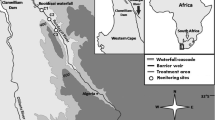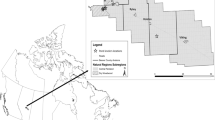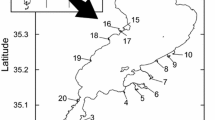Abstract
In order to evaluate the potential risks of human visitation on macroinvertebrate communities in streams, we investigated the effect of trampling using two short-term experiments conducted in a Brazilian ecotourism karst region. We asked three questions: (a) Does trampling increase the drift rate of aquatic macroinvertebrates and organic matter? (b) Does trampling change the macroinvertebrate community organization? (c) If trampling alters the community structure, is a short time (5 days, a between weekends interval - peaks of tourism activities) sufficient for community restructuring? Analysis of variance of richness, total abundance, abundance of the most abundant genus (e.g., Simothraulopsis and Callibaetis), and community composition showed that trampling immediately affects macroinvertebrate community and that the intervals between the peaks of visitation (5 days) are not sufficient to complete community restructuring. Considering that bathing areas receive thousands of visitors every year and that intervals of time without visitation are nearly nonexistent, we suspect that the negative effects on the macroinvertebrate community occur in a cumulative way. Finally, we discuss some simple procedures that could potentially be used for reducing trampling impacts in lotic environments.
Similar content being viewed by others
References
Andersen, A. N. (1995). Resistance of Danish coastal vegetation types to human trampling. Biological Conservation, 71, 223–230.
Anderson, M. J. (2001). A new method for non-parametric multivariate analysis of variance. Austral Ecology, 26, 32–46.
Ayres, E., Nkem, J. N., Wall, D. H., Adams, B. J., Barrett, J. E., Broos, E. J., et al. (2008). Effects of human trampling on populations of soil Fauna in the McMurdo Dry Valleys, Antarctica. Conservation Biology, 22, 1544–1551.
Baptista, D. F. (2008). Uso de macroinvertebrados em procedimentos de biomonitoramento em ecossistemas aquáticos. Oecologia Brasiliensis, 12, 425–441.
Bates, G. H. (1935). Vegetation of footpaths, sidewalks, cart-tracks and gateways. Journal of Ecology, 23, 470–487.
Belnap, J., Phillips, S. L., Herrick, J. K., & Johansen, J. R. (2007). Wind erodibility of soils at Fort Irwin, California (Mojave Desert), USA, before and after trampling disturbance: implications for land management. Earth Surface Processes and Landforms, 32, 75–84.
Boggiani, P. C., Trevelin, A. C., Sallun Filho, W., Oliveira, E. C., & Almeida, L. H. S. (2011). Turismo e Conservação de Tufas Ativas da Serra da Bodoquena, Mato Grosso do Sul. Pesquisas em Turismo e Paisagens Cársticas, 4, 55–63.
Bonada, N., Prat, N., Resh, V. H., & Statzner, B. (2006). Developments in aquatic insect biomonitoring: a comparative analysis of recent approaches. Annual Review of Entomology, 5, 495–523.
Bonte, D., & Maes, D. (2008). Trampling affects the distribution of specialised coastal dune arthropods. Basic and Applied Ecology, 9, 726–734.
Bowles, J., & Maun, M. A. (1982). A study of the effects of trampling on the vegetation of lake Huron sand dunes at Pinery Provincial Park. Biological Conservation, 24, 273–283.
Brinkhurst, R. O., Marchese, M. R. (1989). Guia de la identificacion de Oligoquetos acuaticos continentales de Sud y Centroamerica. Associación Ciencias Naturales del Litoral. Argentina. Colección Climax (5).
Carvalho, E. M., & Uieda, V. S. (2004). Colonização por macroinvertebrados bentônicos em substrato artificial e natural em um riacho da serra de Itatinga, São Paulo, Brasil. Revista Brasileira de Zoologia, 32, 287–293.
Casu, D., Ceccherelli, G., & Castelli, A. (2006a). Immediate effects of experimental human trampling on mid-upper intertidal benthic invertebrates at the Asinara Island MPA (NW Mediterranean). Hydrobiologia, 555, 271–279.
Casu, D., Ceccherelli, G., Curini-Galletti, M., & Castelli, A. (2006b). Short-term effects of experimental trampling on polychaetes of a rocky intertidal substratum (Asinara Island MPA, NW Mediterranean). Scientific Advances in Polychaete Research, 70, 179–186.
Cole, D. N. (1995a). Recreation Trampling Experiments: Effects of Trampler Weight and Shoe Type. Research Note INT-RN-425. Ogden, UT: USDA Forest Service, Intermountain Research Station.
Cole, D. N. (1995b). Experimental trampling of vegetation. II. Predictors of resistance and resilience. Journal of Applied Ecology, 32, 215–224.
Cole, D., & Landres, P. B. (1996). Threats to wilderness ecosystems: impacts and research needs. Ecological Applications, 6, 168–184.
Cummins, K. W., & Klug, M. J. (1979). Feeding ecology of stream invertebrates. Annual Review of Ecology and Systematic, 10, 147–172.
Davenport, J., & Davenport, J. L. (2006). The impact of tourism and personal leisure transport on coastal environments: a review. Estuarine, Coastal and Shelf Science, 67, 280–292.
Dominguez, E., Molineri, C., Pescador, M. L., Hubbard, M. D., & Nieto, C. (2006). Aquatic Biodiversity of Latin America. Ephemeroptera of South America. Bulgaria: Pensoft.
Escarpinati, S. C., Roque, F. O., Medina-Jr, P. B., & Raizer, J. (2011). Macroinvertebrate community in recreational areas in a karst river (Bonito, Brazil): implications for biomonitoring of tourist activities. Tourism and Karst Areas, 4, 121–130.
Fennell, D., & Weaver, D. (2005). The ecotourism concept and tourism-conservation symbiosis. Journal of Sustainable Tourism, 13, 373–390.
Foin, T. C., Riley, S. D., Pawley, A. L., Ayres, D. R., Carlsen, T. M., Hodum, P. J., & Switzer, P. V. (1998). Improving recovery planning for threatened and endangered species. BioScience, 48, 177–184.
Froehlich, C. G. (org.) (2007). Guia on-line: Identificação de larvas de Insetos Aquáticos do Estado de São Paulo. http://sites.ffclrp.usp.br/aguadoce/guiaonline. Accessed 21 June 2011.
García-Charton, J. A., Pérez-Ruzafaa, A., Marcos, C., Claudet, J., Badalamentic, F., Benedetti-Cecchid, L., et al. (2008). Effectiveness of European Atlanto-Mediterranean MPAs: Do they accomplish the expected effects on populations, communities and ecosystems? Journal for Nature Conservation, 16, 193–221.
Hall, D. C., Hall, J. V., & Murray, S. N. (2002). Contingent valuation of marine protected areas: Southern California rocky intertidal ecosystems. Natural Resource Modeling, 15, 335–368.
Heil, L., Fernandez-Juricic, E., Renison, D., Cingolani, A. M., & Blumstein, D. T. (2005). Avian responses to tourism in the biogeographically isolated high Córdoba Mountains, Argentina. Biodiversity and Conservation, 16, 1009–1026.
Hylgaard, T. (1980). Recovery of plant communities on coastal sand-dunes disturbed by human trampling. Biological Conservation, 19, 15–25.
Hylgaard, T., & Liddle, M. J. (1981). The effect of human trampling on a sand dune ecosystem dominated by Empetrum nigrum. Journal of Applied Ecology, 18, 559–669.
Ieser, N., & Melo, A. L. (1997). Os Heterópteros Aquáticos de Minas Gerais - Guia Introdutório com Chave de Identificação para as Espécies de Nepomorpha eGerromorpha. Belo Horizonte: UFMG.
Jones, F. C. (2008). Taxonomic sufficiency: the influence of taxonomic resolution on freshwater bioassessments using benthic macroinvertebrates. Environmental Reviews, 16, 45–69.
Liddle, M. J., & Greig-Smith, P. (1975). A survey of tracks and paths in a sand dune ecosystem, II. Vegetation. Journal of Applied Ecology, 12, 909–930.
Lods-Crozet, B., & Castella, E. (2009). Colonisation by midges (Chironomidae, Diptera) of recently-created shallow ponds: implications for the restoration of lacustrine fringing wetlands. Annales de Limnologie, 45, 257–266.
Marshall, J. C., Steward, A. L., & Harch, B. D. (2006). Taxonomic resolution and quantification of freshwater macroinvertebrate samples from an Australian dryland river: the benefits and costs of using species abundance data. Hydrobiologia, 572, 171–194.
McCabe, D. J., & Gotelli, N. J. (2000). Effects of disturbance frequency, intensity, and area on assemblages of stream macroinvertebrates. Oecologia, 124, 270–279.
Melo, A. S. (2005). Effects of taxonomic and numeric resolution on the ability to detect ecological patterns at a local scale using stream macroinvertebrates. Archiv für Hydrobiologie, 164, 309–323.
Melo, A. S., Niyogi, D. K., Matthaei, C. D., & Townsend, C. R. (2003). Resistance, resilience, and patchiness of invertebrate assemblages in native tussock and pasture streams in New Zealand after a hydrological disturbance. Canadian Journal of Fisheries and Aquatic Sciences, 60, 731–739.
Millennium Ecosystem Assessment. (2003). Ecosystems and human well-being: a framework for assessment. Washington: Island.
Newsome, D., Dowling, R. K., & Moore, S. A. (2005). Wildlife Tourism. Clevedon: Channel View.
Oksanen, J., Blanchet, F. G., Kindt, R., Legendre, P., O’Hara, R. B., Simpson, G. L., Solymos, P., Stevens, M. H. H., & Wagner, H. (2013). vegan: Community Ecology Package. R package version 2.0-8. http://CRAN.R-project.org/package=vegan. Accessed 05 August 2013.
Paul, M. J., & Meyer, J. L. (2001). Streams in the urban landscape. Urban Ecology, 32, 207–231.
Peres-Neto, P. R., & Jackson, D. A. (2001). How well do multivariate data sets match? The advantages of a Procrustean superimposition approach over the Mantel test. Oecologia, 129, 169–178.
R Development Core Team. (2011). R: A language and environment for statistical computing. R Foundation for Statistical Computing, Vienna, Austria. ISBN 3-900051-07-0, URL http://www.R-project.org/. Accessed 03 September 2012.
Roni, P., Beechie, T. J., Bilby, R. E., Leonetti, F. E., Pollock, M. M., & Pess, G. R. (2002). A review of stream restoration techniques and a hierarchical strategy for prioritizing restoration in Pacific Northwest Watersheds. North American Journal of Fisheries Management, 22, 1–20.
Rosenberg, D. M., & Resh, V. H. (1993). Freshwater Biomonitoring and Benthic Macroinvertebrates. New York: Chapman and Hall.
Ruhí, A., Boix, D., Gascón, S., Sala, J., & Quintana, X. (2013). Nestedness and successional trajectories of macroinvertebrate assemblages in man-made wetlands. Oecologia, 171, 545–556.
Russel, W. M. S., & Burch, R. L. (1992). The Principles of Humane Experimental Techniques (Specialth ed.). Herts: Universities Federation for Animal Welfare.
Sabino, J., Medina-Jr, P. B., & Andrade, L. P. (2005). Visitantes mal-comportados e piraputangas obesas: a pressão da visitação pública sobre Brycon hilari no Balneário municipal de Bonito, Mato Grosso do Sul. Anais do Encontro Nacional de Inovação Científica Para o Homem do Século XXI, Campo Grande, 1, 321–332.
Scudder, K. M., Pasanello, E., Krafsur, J., & Ross, K. (1981). Analysis of locomotory activity in juvenile giant Malaysian prawns, Macrobrachium rosenbergii (De Man) (Decapoda, Palaemonidae). Crustaceana, 40, 31–35.
Stanley, E. H., Powers, S. M., & Lottig, N. R. (2010). The evolving legacy of disturbance in stream ecology: concepts, contributions, and coming challenges. Journal of the North American Benthological Society, 29(1), 67–83.
Trivinho-Strixino, S. (2011). Larvas de Chironomidae: Guia de identificação. São Carlos: UFSCar.
Turton, M. S. (2005). Managing environmental impacts of recreation and tourism in rainforests of the wet tropics of Queensland World Heritage Area. Geographical Research, 43, 140–151.
Ugolini, A., Ungherese, G., Somigli, S., Galanti, G., Baroni, D., Borghini, F., et al. (2008). The amphipod Talitrus saltator as a bioindicator of human trampling on sandy beaches. Marine Environmental Research, 65, 349–357.
UNESCO. (1995). Declaration of Principles on Tolerance. Paris: UNESCO.
Acknowledgments
We are grateful to Fundação O Boticário de Proteção à Natureza for their financial support (Project 0791_20081). We are also grateful to the entrepreneurs and the Tourism Secretary of Bonito, MS-Brazil. This work was partly supported by the Conselho Nacional de Desenvolvimento Científico e Tecnológico (Project 476484/2008-1) and the Coordenação de Aperfeiçoamento de Pessoal de Nível Superior. We express our gratitude for the specimens’ identification to Melissa O. Segura–PhD, Coleoptera; Frederico Falcão Salles–PhD, Ephemeroptera; Rafael Moretto–PhD student, Trichoptera; Silvana Thiengo–PhD Molusca; Lucas Lecci–PhD, Plecoptera; and Juliana Freires–PhD student, Hemiptera. We express our gratitude also to Raquel Taminato and Julie Teresa Shapiro for reviewing the technical language. F.O. Roque receives a productivity grant from the CNPq (Process 303293/2009-8).
Author information
Authors and Affiliations
Corresponding author
Rights and permissions
About this article
Cite this article
Escarpinati, S.C., Siqueira, T., Medina-Jr, P.B. et al. Short-term effects of visitor trampling on macroinvertebrates in karst streams in an ecotourism region. Environ Monit Assess 186, 1655–1663 (2014). https://doi.org/10.1007/s10661-013-3483-x
Received:
Accepted:
Published:
Issue Date:
DOI: https://doi.org/10.1007/s10661-013-3483-x




